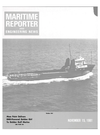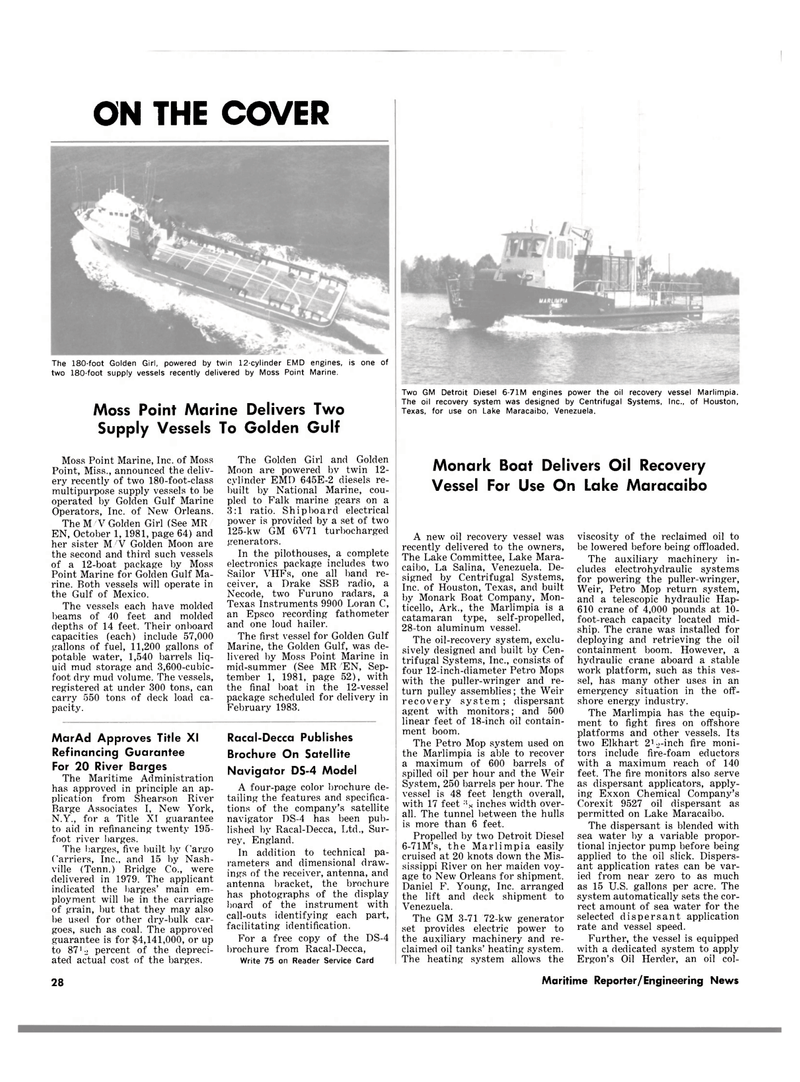
Page 24: of Maritime Reporter Magazine (November 15, 1981)
Read this page in Pdf, Flash or Html5 edition of November 15, 1981 Maritime Reporter Magazine
ON THE COVER
The 180-foot Golden Girl, powered by twin 12-cylinder EMD engines, is one of two 180-foot supply vessels recently delivered by Moss Point Marine.
Moss Point Marine Delivers Two
Supply Vessels To Golden Gulf
Moss Point Marine, Inc. of Moss
Point, Miss., announced the deliv- ery recently of two 180-foot-class multipurpose supply vessels to be operated by Golden Gulf Marine
Operators, Inc. of New Orleans.
The M V Golden Girl (See MR
EN, October 1, 1981, page 64) and her sister M V Golden Moon are the second and third such vessels of a 12-boat package by Moss
Point Marine for Golden Gulf Ma- rine. Both vessels will operate in the Gulf of Mexico.
The vessels each have molded beams of 40 feet and molded depths of 14 feet. Their onboard capacities (each) include 57,000 gallons of fuel, 11,200 gallons of potable water, 1,540 barrels liq- uid mud storage and 3,600-cubic- foot dry mud volume. The vessels, registered at under 300 tons, can carry 550 tons of deck load ca- pacity.
The Golden Girl and Golden
Moon are powered bv twin 12- cylinder EMD 645E-2 diesels re- built by National Marine, cou- pled to Falk marine gears on a 3:1 ratio. Shipboard electrical power is provided by a set of two 125-kw GM 6V71 turbocharged generators.
In the pilothouses, a complete electronics package includes two
Sailor YHFs, one all band re- ceiver, a Drake SSB radio, a
Necode, two Furuno radars, a
Texas Instruments 9900 Loran C, an Epsco recording fathometer and one loud hailer.
The first vessel for Golden Gulf
Marine, the Golden Gulf, was de- livered by Moss Point Marine in mid-summer (See MR 'EN, Sep- tember 1, 1981, page 52), with the final boat in the 12-vessel package scheduled for delivery in
February 1983.
MarAd Approves Title XI
Refinancing Guarantee
For 20 River Barges
The Maritime Administration has approved in principle an ap- plication from Shearson River
Barge Associates I, New York,
N.Y., for a Title XI guarantee to aid in refinancing twenty 195- foot river barges.
The barges, five built by Cargo
Carriers, Inc., and 15 by Nash- ville (Tenn.) Bridge Co., were delivered in 1979. The applicant indicated the barges' main em- ployment will be in the carriage of grain, but that they may also be used for other dry-bulk car- goes, such as coal. The approved guarantee is for $4,141,000, or up to 87'2 percent of the depreci- ated actual cost of the barges.
Racal-Decca Publishes
Broch ure On Satellite
Navigator DS-4 Model
A four-page color brochure de- tailing the features and specifica- tions of the company's satellite navigator DS-4 has been pub- lished by Racal-Decca, Ltd., Sur- rey, England.
In addition to technical pa- rameters and dimensional draw- ings of the receiver, antenna, and antenna bracket, the brochure has photographs of the display hoard of the instrument with call-outs identifying each part, facilitating identification.
For a free copy of the DS-4 brochure from Racal-Decca,
Write 75 on Reader Service Card
Two GM Detroit Diesel 6-71M engines power the oil recovery vessel Marlimpia.
The oil recovery system was designed by Centrifugal Systems, Inc., of Houston,
Texas, for use on Lake Maracaibo, Venezuela.
Monark Boat Delivers Oil Recovery
Vessel For Use On Lake Maracaibo
A new oil recovery vessel was recently delivered to the owners,
The Lake Committee, Lake Mara- caibo, La Salina, Venezuela. De- signed by Centrifugal Systems,
Inc. of Houston, Texas, and built by Monark Boat Company, Mon- ticello, Ark., the Marlimpia is a catamaran type, self-propelled, 28-ton aluminum vessel.
The oil-recovery system, exclu- sively designed and built by Cen- trifugal Systems, Inc., consists of four 12-inch-diameter Petro Mops with the puller-wringer and re- turn pulley assemblies ; the Weir recovery system ; dispersant agent with monitors; and 500 linear feet of 18-inch oil contain- ment boom.
The Petro Mop system used on the Marlimpia is able to recover a maximum of 600 barrels of spilled oil per hour and the Weir
System, 250 barrels per hour. The vessel is 48 feet length overall, with 17 feet :is inches width over- all. The tunnel between the hulls is more than 6 feet.
Propelled by two Detroit Diesel 6-71M's, the Marlimpia easily cruised at 20 knots down the Mis- sissippi River on her maiden voy- age to New Orleans for shipment.
Daniel F. Young, Inc. arranged the lift and deck shipment to
Venezuela.
The GM 3-71 72-kw generator set provides electric power to the auxiliary machinery and re- claimed oil tanks' heating system.
The heating system allows the viscosity of the reclaimed oil to be lowered before being offloaded.
The auxiliary machinery in- cludes electrohydraulic systems for powering the puller-wringer,
Weir, Petro Mop return system, and a telescopic hydraulic Hap- 610 crane of 4,000 pounds at 10- foot-reach capacity located mid- ship. The crane was installed for deploying and retrieving the oil containment boom. However, a hydraulic crane aboard a stable work platform, such as this ves- sel, has many other uses in an emergency situation in the off- shore energy industry.
The Marlimpia has the equip- ment to fight fires on offshore platforms and other vessels. Its two Elkhart 21L>-inch fire moni- tors include fire-foam eductors with a maximum reach of 140 feet. The fire monitors also serve as dispersant applicators, apply- ing Exxon Chemical Company's
Corexit 9527 oil dispersant as permitted on Lake Maracaibo.
The dispersant is blended with sea water by a variable propor- tional injector pump before being applied to the oil slick. Dispers- ant application rates can be var- ied from near zero to as much as 15 U.S. gallons per acre. The system automatically sets the cor- rect amount of sea water for the selected dispersant application rate and vessel speed.
Further, the vessel is equipped with a dedicated system to apply
Ergon's Oil Herder, an oil col- 28 Maritime Reporter/Engineering News

 23
23

 25
25
